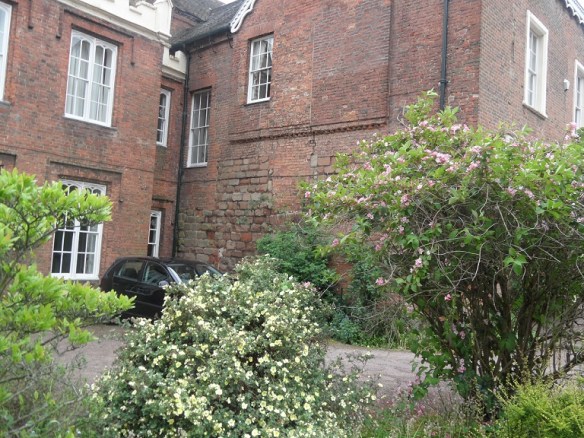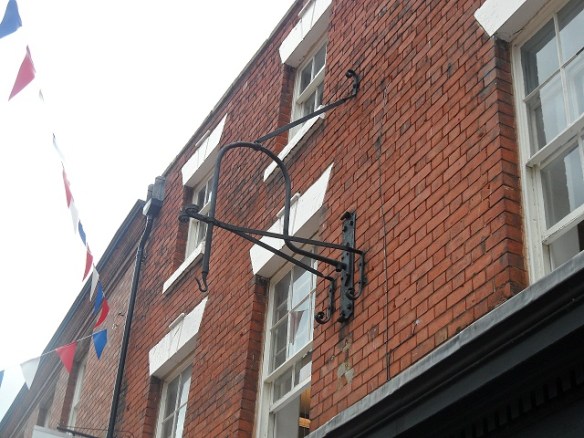This morning, I went to the dentist. On the way home I walked past St John’s Hospital. With the sun shining, I decided to pop in and allow myself a minute to take in the lovely surroundings and the calm atmosphere of the courtyard, before heading home.
At least that was my intention. As hospitable as ever, someone in the courtyard came over to welcome me, and invited me to have a look around the chapel. Never one to miss an opportunity to be nosey, I accepted with thanks.
I have been inside once before, but that visit was dominated by standing in front of John Piper’s striking window for the first time. Today, I sat on a back pew and found myself next to a perspex window. A small sticker told me that the stonework behind the perspex was the remains of a Norman water stoup. I understand that this would once have held holy water, into which those entering the chapel could dip their fingers, and make the sign of the cross. Apparently, many stoups were destroyed during the reformation but whether this is the case here I don’t know. As the chapel has been heavily restored and altered over the centuries, I was delighted to have this chance encounter with part of the older fabric of the chapel. Unfortunately, as I hadn’t anticipated there being many photo opportunities on a trip to the dentists, I had no camera. But the chapel is open everyday until 5pm, so if you can, please do go and take a look yourself, and enjoy visiting the grounds at the same time.
This got me thinking about the idea of layers of history within buildings, where generations of people have made their mark, by accident or by design, for better or for worse. When I was volunteering at the Guildhall, someone told me I could get out using the back door. It was news to me that there was a back door but once through it, I made the even more exciting discovery that traces of the older building were still in evidence. For example, whilst the main hall and the front of the Guildhall date to the mid 1800s, the blocked window on the photograph below is thought to date to the 16thc.
Another couple of examples to be going on with – what’s gone on here with all the different brickwork at this house in The Close?
This metal….thing, above a restaurant on Bird St, must have played some role in the building’s past, but what?
And when we’re talking about layers of history, should we also consider the present and future of buildings? I notice that the Angel Croft hotel has unsurprisingly made its annual appearance on the English Heritage At Risk register…..
Sources




It’s fascinating, I agree. And looking up can harvest some good results. That’s an interesting metal thing. It looks like the frame for a sign or a clock – but then, there’s the hook . . . Wondering if it was a jeweller’s /clockmaker’s shop which had the three balls hanging . . . Do you know the answer?
LikeLike
I thought it looked like some sort of sign. I don’t know the answer at the moment but I think with old photos & old directories,I might be able to find out!
LikeLike
More great snooping on your part Kate,I thing your bracket
may be for a lantern ,What ever it was for fantastic workmanship
Lichfield has some wonderful ironwork ,A large amount of iron
work was removed from towns & cities for the war effort both
for 1914-1918 and 1939-1945 wars so it is all the more delightful
when you find examples ,Keep looking upwards Kate.
LikeLike
Thanks Pat. A lantern would make sense. I really do like decorative ironwork. I remember my Grandad telling me about the railings around the cemetery in Yardley being taken for the war effort. I think we need to keep looking up, down, up close & far away to get this place to reveal its secrets 😉
LikeLike
I’ve been past St John’s so many times, and I’m always intrigued by those huge chimney things (is there a correct architectural term for them?) running all the way up from the pavement. But I’ve never been inside, and I assumed the chapel was just for residents, so I will pop in next time I’m in Lichfield – with a camera of course!
LikeLike
Apparently, they are the oldest domestic chimneys in the country but I have no hard evidence to back that up! I’ve read that they are tudor. I’m wondering if there’s a thing with chimneys and almshouses – look at this http://www.hevac-heritage.org/electronic_books/chimneys/5-ALMSHOUSES.pdf and there are the lovely barley twist ones in Rushall on the Walsall Rd http://www.flickr.com/photos/ziksby/6430288285/
For a long time I had assumed that it wasn’t open but they hold services there, even weddings and I think they’ve just had some new info boards installed to encourage people to visit. You’ll love it but yes, do remember your camera!
LikeLike
The book ‘Look At Lichfield’ calls it a lantern holder.
LikeLike
Pingback: Written into Lichfield history | Lichfield Lore
The Guy almshouses in Tamworth are wonderful .
LikeLike